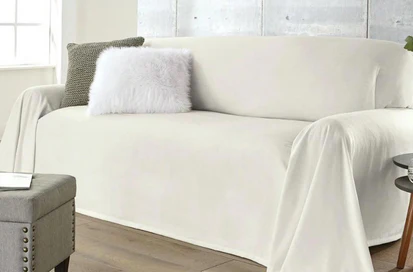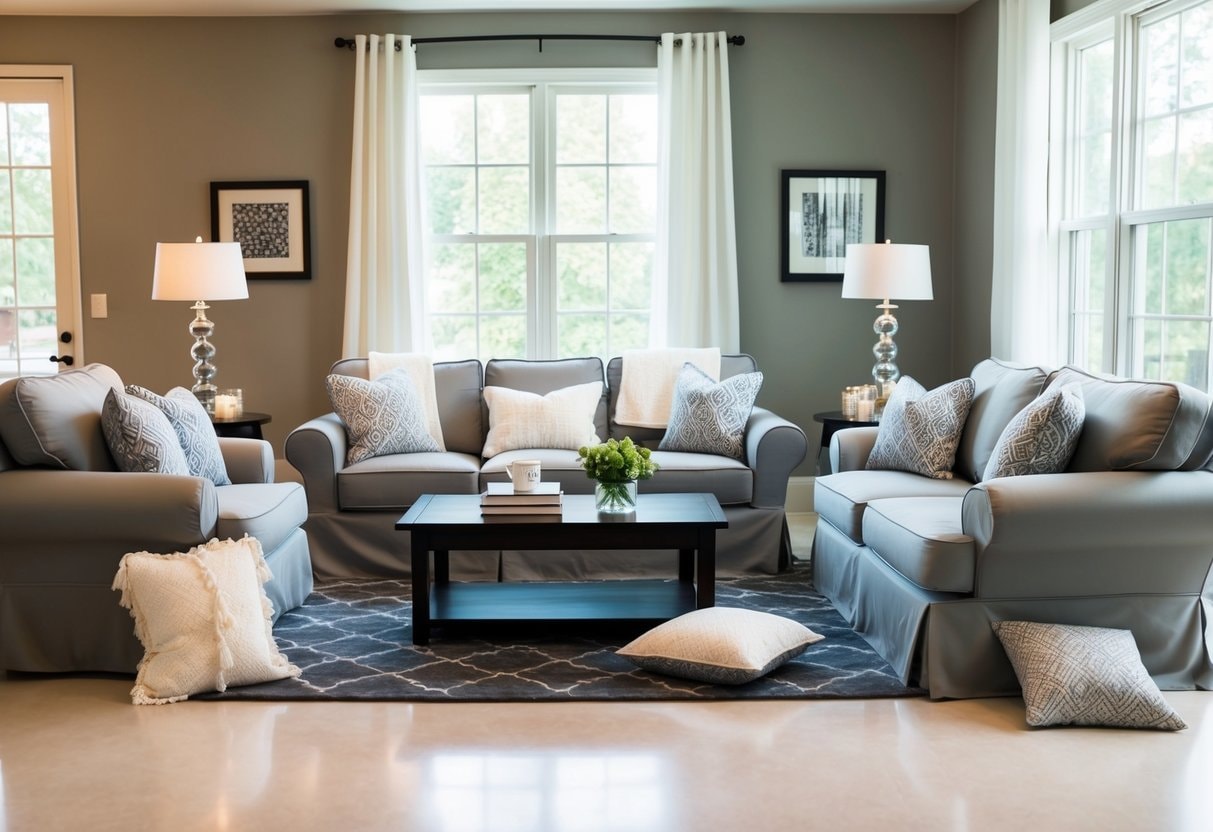LifeWithMyDogs is supported by our audience. When you purchase through one of our links, we may earn a small affiliate commission. As an Amazon Associate I earn from qualifying purchases. Your cost is not affected.
**********
Furniture covers for allergy sufferers can significantly enhance the comfort and health of your home. Dust mites, pet dander, and pollen often accumulate on sofas, chairs, and beds, making your furniture an allergy trap. Investing in the right covers creates a protective barrier that reduces allergens, helping you breathe easier indoors. With innovative designs and hypoallergenic materials, furniture covers for allergy sufferers combine practicality and style to create a cozy, allergen-free space.
But what makes some furniture covers better suited for allergy relief than others? In this article, we’ll explore the key features to look for, from hypoallergenic fabrics to easy-care options that fit seamlessly into your lifestyle. Whether battling seasonal allergies or year-round sensitivities, these tips and recommendations will help you transform your home into a healthier, more comfortable haven.
Allergy-Friendly Furniture Covers: Creating a Healthier Home Environment
Living with allergies can be tough, especially when your furniture is home for allergens. But don’t worry! There’s a simple solution that can make your living space more comfortable. Furniture covers for allergy sufferers are designed to help reduce allergens like dust mites, pet dander, and pollen in your home. These special covers are a barrier, keeping allergens from settling into your furniture. This means fewer sneezes and sniffles for you!
Picking the right cover is key. Leather and velvet are great options; they’re smooth and easy to clean. Look for covers that fit snugly and are made from hypoallergenic materials. With the right furniture covers, you can breathe easier and enjoy your living room more.
Key Takeaways
-
Furniture covers are designed to create a protective shield against common indoor allergens like dust mites, pet dander, and pollen. Acting as a barrier reduces allergens from settling into your furniture, leading to fewer allergy symptoms in your home.
-
Choosing covers made from hypoallergenic materials, such as microfiber or organic cotton, helps keep allergens at bay. These materials are breathable, easy to clean, and can be washed in hot water to effectively remove dust mites and other allergens.
-
Regular cleaning is key to maintaining an allergen-free home. Furniture covers are easy to remove and wash, helping to eliminate allergens. Washing in hot water (at least 130°F) kills dust mites, while routine vacuuming with a HEPA filter helps remove additional allergens from the surfaces.
-
For the best allergen protection, furniture covers should fit snugly. Features like elastic edges, zipper closures, and tie-downs help secure the cover, preventing allergens from sneaking through gaps. The right fit ensures comprehensive protection for your furniture and bedding.
-
In addition to using furniture covers, maintaining a clean living space is essential. Regularly vacuuming, low humidity levels, and airing out your home can further reduce allergens. Using allergen-proof covers on mattresses and pillows and keeping pets off furniture can provide additional allergy relief.
Understanding Allergies in the Home
Allergens can be hidden in many places around your home. Knowing what causes allergies and how they affect you is key to creating a healthier living space.
Common Indoor Allergens
Your home might have several allergy triggers. Dust mites are tiny bugs that live in bedding and furniture. They love warm, humid spots. Pet dander comes from your furry friends’ skin flakes. It can float in the air and stick to surfaces.
Pollen sneaks in through open windows or on your clothes. It’s most common in spring and fall. Mold and mildew grow in damp areas like bathrooms and basements. They release spores into the air. To fight these allergens, try these tips:
- Use dust-mite-proof covers on your bedding.
- Clean often with a damp cloth.
- Keep pets out of bedrooms.
- Use air purifiers.
The Impact of Allergens on Health
Allergies can make you feel pretty awful. You might get a stuffy nose, itchy eyes, or start sneezing a lot. Some people have worse symptoms. Asthma attacks can happen when allergens irritate your lungs. This makes it hard to breathe.
Allergies can also mess with your sleep. You might feel tired all day if you can’t breathe well at night. Long-term exposure to allergens can lead to other health issues. Your immune system stays on high alert, which isn’t good for your body.
To feel better, try to remove allergens from your home. Hypoallergenic furniture can help. It’s made to keep allergens away.
Here’s an additional video about dog dander allergies.
By: Growing up Govani
Diving Deeper on How Dog Fur Can Trigger Allergies
It’s not the dog’s hair or fur that directly causes allergies. Instead, the culprits are proteins found in their dander (dead skin cells), saliva, and urine. These proteins can provoke allergic reactions in sensitive individuals. Here’s what happens:
- Dander: Tiny flakes of skin that dogs naturally shed. Lightweight and easily airborne, dander can quickly spread throughout your home.
- Saliva and Urine: Both contain allergy-triggering proteins that, once dried, can become airborne and contribute to allergic reactions.
The Main Point
- The Proteins, Not the Fur: Allergies stem from proteins in dander, saliva, and urine—not the hair itself.
- Dander as the Main Trigger: Lightweight and easily airborne, dander is a major cause of allergic reactions.
- All Dogs Can Be Allergic Triggers: Regardless of breed or coat type, any dog can potentially cause allergies.
- Consult an Expert: If you experience allergy symptoms around dogs, consult an allergist to identify the specific allergen and explore treatment options.
Benefits of Furniture Covers for Allergy Sufferers
Furniture covers can be a game-changer for allergy sufferers. They create a barrier between you and potential allergens, making your home more comfortable. These covers also make cleaning easier, helping you maintain a healthier living space.
Reducing Exposure to Allergens
Dust mite-proof covers can significantly reduce your exposure to common allergens. They act as a shield, keeping dust mites, pet dander, and pollen away from your furniture’s surfaces. Microfiber covers are especially effective. Their tightly woven fibers trap allergens, preventing them from becoming airborne when you sit or move on the furniture.
For extra protection, look for covers labeled as “hypoallergenic.” These are designed to be less likely to cause allergic reactions. Cotton covers are also a good choice. They’re breathable and easily washed in hot water to remove allergens.
Ease of Cleaning and Maintenance
Furniture covers make cleaning a breeze. You can remove them and toss them in the wash, eliminating allergens that have collected on the surface. Wash your covers weekly in hot water (at least 130°F) for best results. This kills dust mites and removes other allergens effectively.
Some covers are stain-resistant, making it easier to keep your furniture clean and fresh. This is especially helpful if you have pets or young children. Remember to vacuum your covered furniture regularly, too. This helps remove allergens that may have settled on the surface between washes.
Did You Know?
Hypoallergenic covers can effectively block common allergens like dust mites and pet dander! High-quality Furniture Covers for Allergy Sufferers create a physical barrier that allergens can’t penetrate. Covers with 10 microns or less pore sizes are particularly effective at keeping most allergens at bay. While no cover is completely foolproof, they can significantly reduce your exposure, helping to make your home a healthier and more comfortable space.
Choosing the Right Furniture Covers
Picking the best furniture covers for allergy sufferers can make a big difference in maintaining a healthier living space. The right material and fit are key to keeping allergens at bay and protecting your health.
Material Considerations for Allergy Prevention
When looking for allergy-friendly furniture covers, microfiber and cotton are great choices. Microfiber is tightly woven, making it hard for allergens to stick. It’s also easy to clean and durable. Cotton is breathable and natural. It’s less likely to cause skin reactions. Look for organic cotton to avoid pesticides that might trigger allergies.
Both materials come in hypoallergenic options. These are treated to resist dust mites, mold, and other allergens. Remember to wash your covers often. Hot water kills dust mites and removes allergens. Choose covers you can easily take off and clean.
Size and Fit for Optimal Protection
The right size and fit are crucial for keeping allergens out. Measure your furniture carefully before buying covers. A snug fit leaves no gaps for allergens to sneak through. Look for covers with:
-
Elastic edges.
-
Tie-downs.
-
Zipper closures.
These features help the cover stay in place. They also make it easier to put on and take off. For mattresses and pillows, use dust-mite-proof covers. These have special zippers that create a barrier against allergens. Don’t forget about decorative pillows and cushions. Cover these, too, or choose ones with removable, washable covers.
Maintaining a Clean Living Space
Keeping your living space clean is key for allergy sufferers, and furniture covers for allergy sufferers can play a significant role. Regular cleaning and smart choices, such as using these specialized covers, can greatly reduce allergens in your home.
Regular Washing and Care of Furniture Covers
Wash your furniture covers often to remove dust mites, pet dander, and pollen. Use hot water (at least 130°F) to kill these pesky allergens. If possible, dry covers in direct sunlight to zap any leftover dust mites.
Vacuum your furniture weekly with a HEPA filter vacuum. This picks up tiny particles that can trigger allergies. Don’t forget to clean under cushions and in crevices where dust likes to hide.
Wipe them down with a damp cloth every few days for leather or faux leather covers. This stops dust and dander from building up. Use a leather cleaner once a month for deeper cleaning.
Additional Tips for Allergen Reduction
Keep your home’s humidity below 50% to stop mold and dust mites from thriving. Use a dehumidifier if needed, especially in damp areas like basements. Choose furniture with raised legs to make cleaning underneath easier. This cuts down on dust buildup.
Use allergen-proof covers on mattresses and pillows. These block dust mites from setting up shop in your bedding. Air out your home regularly by opening windows on low-pollen days. This helps remove indoor allergens and brings in fresh air.
Keep pets out of bedrooms and off furniture if possible. If not, brush them often to reduce loose hair and dander.
Creating an Allergen-Free Haven with Furniture Covers
Creating an allergen-free home is essential for improving comfort and overall well-being, especially for those with sensitivities. Furniture Covers for Allergy Sufferers offer a simple yet highly effective way to combat allergens like dust mites, pet dander, and pollen. Acting as a protective barrier, these covers help reduce allergen buildup, making your living space healthier and more enjoyable.
Choosing the right covers is crucial for maximizing their benefits. Hypoallergenic materials such as microfiber or cotton and features like snug fits and easy maintenance provide optimal protection. Regular cleaning of these covers ensures allergens are removed effectively, helping you maintain a consistently safe environment. With options catering to functionality and style, allergy-friendly furniture covers can seamlessly blend into any decor.
By incorporating these covers and following smart cleaning habits, you can significantly reduce allergen exposure in your home. Whether dealing with seasonal allergies or year-round sensitivities, investing in the right furniture covers is worthwhile. Breathe easier, live more comfortably, and create a healthier haven for yourself and your loved ones.
Frequently Asked Questions
Choosing the right furniture covers can make a big difference for allergy sufferers. Let’s look at some common questions about how to use allergy-friendly options effectively.
What Types of Materials Should I Look for When Choosing Allergy-Friendly Furniture Covers?
Look for covers made from tightly woven fabrics. Microfiber is a great choice. It’s smooth and prevents allergens from getting through. Vinyl and plastic covers also work well. They create a barrier that allergens can’t penetrate. Avoid materials like wool or feathers. These can trap allergens and make symptoms worse.
How Can Furniture Covers Help Reduce Allergy Symptoms?
Covers act as a shield between you and allergens. They keep dust mites, pet dander, and pollen from settling into your furniture. By using covers, you create a cleaner surface. This means fewer allergens in your living space. Covers also make it easier to clean your furniture. You can remove and wash them regularly.
Are There Specific Couch Cover Brands Recommended for People With Allergies?
Yes, some brands focus on allergy-friendly covers. Look for ones that advertise as hypoallergenic or allergen-proof. Mission: Allergy makes good covers. They use special fabrics to block allergens. Protect-A-Bed is another brand to check out. They offer covers for various furniture types.
What Features Do Allergen Barrier Bedding and Covers Have That Help With Allergies?
Allergen barrier covers have very tight weaves. This stops tiny allergens from getting through. Many have waterproof layers. This prevents moisture buildup that can lead to mold or mildew. Some covers use special treatments. These can repel or neutralize allergens on contact.
How Often Should I Clean or Replace My Allergy-proof Furniture Covers to Maintain Effectiveness?
Clean your covers every 2-3 months. You might need to do it more often if it’s allergy season. Wash covers in hot water (at least 130°F). This kills dust mites and removes allergens. Replace covers if they get worn or damaged. Holes or tears can let allergens through.
Celebrate Your Love for Dogs With Us!
Engage with like-minded enthusiasts, access exclusive content, and stay updated with our latest product reviews.
- Facebook: Life With My Dogs
- Instagram: @LifeWithMyDogs2
- Pinterest: Life With My Dogs
- YouTube: Life With My Dogs







